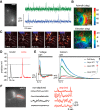Genetically Encoded Voltage Indicators: Opportunities and Challenges
- PMID: 27683896
- PMCID: PMC5039263
- DOI: 10.1523/JNEUROSCI.1095-16.2016
Genetically Encoded Voltage Indicators: Opportunities and Challenges
Abstract
A longstanding goal in neuroscience is to understand how spatiotemporal patterns of neuronal electrical activity underlie brain function, from sensory representations to decision making. An emerging technology for monitoring electrical dynamics, voltage imaging using genetically encoded voltage indicators (GEVIs), couples the power of genetics with the advantages of light. Here, we review the properties that determine indicator performance and applicability, discussing both recent progress and technical limitations. We then consider GEVI applications, highlighting studies that have already deployed GEVIs for biological discovery. We also examine which classes of biological questions GEVIs are primed to address and which ones are beyond their current capabilities. As GEVIs are further developed, we anticipate that they will become more broadly used by the neuroscience community to eavesdrop on brain activity with unprecedented spatiotemporal resolution.
Significance statement: Genetically encoded voltage indicators are engineered light-emitting protein sensors that typically report neuronal voltage dynamics as changes in brightness. In this review, we systematically discuss the current state of this emerging method, considering both its advantages and limitations for imaging neural activity. We also present recent applications of this technology and discuss what is feasible now and what we anticipate will become possible with future indicator development. This review will inform neuroscientists of recent progress in the field and help potential users critically evaluate the suitability of genetically encoded voltage indicator imaging to answer their specific biological questions.
Keywords: biosensors; fluorescence imaging; genetically encoded voltage indicators (GEVI); voltage imaging.
Copyright © 2016 the authors 0270-6474/16/369977-13$15.00/0.
Figures




Similar articles
-
Optical voltage imaging in neurons: moving from technology development to practical tool.Nat Rev Neurosci. 2019 Dec;20(12):719-727. doi: 10.1038/s41583-019-0231-4. Epub 2019 Nov 8. Nat Rev Neurosci. 2019. PMID: 31705060 Review.
-
Genetically encoded fluorescent voltage indicators: are we there yet?Curr Opin Neurobiol. 2018 Jun;50:146-153. doi: 10.1016/j.conb.2018.02.006. Epub 2018 Mar 20. Curr Opin Neurobiol. 2018. PMID: 29501950 Free PMC article. Review.
-
Genetically encoded voltage indicators for large scale cortical imaging come of age.Curr Opin Chem Biol. 2015 Aug;27:75-83. doi: 10.1016/j.cbpa.2015.06.006. Epub 2015 Jun 24. Curr Opin Chem Biol. 2015. PMID: 26115448 Review.
-
Current progress in genetically encoded voltage indicators for neural activity recording.Curr Opin Chem Biol. 2016 Aug;33:95-100. doi: 10.1016/j.cbpa.2016.05.023. Epub 2016 Jun 17. Curr Opin Chem Biol. 2016. PMID: 27322400 Review.
-
Genetically Encoded Voltage Indicators.Adv Exp Med Biol. 2021;1293:209-224. doi: 10.1007/978-981-15-8763-4_12. Adv Exp Med Biol. 2021. PMID: 33398815 Review.
Cited by
-
Widefield imaging of rapid pan-cortical voltage dynamics with an indicator evolved for one-photon microscopy.Nat Commun. 2023 Oct 12;14(1):6423. doi: 10.1038/s41467-023-41975-3. Nat Commun. 2023. PMID: 37828037 Free PMC article.
-
Optical Quantal Analysis.Front Synaptic Neurosci. 2019 Mar 26;11:8. doi: 10.3389/fnsyn.2019.00008. eCollection 2019. Front Synaptic Neurosci. 2019. PMID: 30971909 Free PMC article.
-
Astroglial Glutamate Signaling and Uptake in the Hippocampus.Front Mol Neurosci. 2018 Jan 17;10:451. doi: 10.3389/fnmol.2017.00451. eCollection 2017. Front Mol Neurosci. 2018. PMID: 29386994 Free PMC article. Review.
-
New Neuroscience Tools That Are Identifying the Sleep-Wake Circuit.Sleep. 2017 Apr 1;40(4):zsx032. doi: 10.1093/sleep/zsx032. Sleep. 2017. PMID: 28329204 Free PMC article. Review.
-
Monitoring In Vivo Neural Activity to Understand Gut-Brain Signaling.Endocrinology. 2021 May 1;162(5):bqab029. doi: 10.1210/endocr/bqab029. Endocrinology. 2021. PMID: 33558881 Free PMC article. Review.
References
-
- Abdelfattah AS, Farhi SL, Zhao Y, Brinks D, Zou P, Ruangkittisakul A, Platisa J, Pieribone VA, Ballanyi K, Cohen AE, Campbell RE. A bright and fast red fluorescent protein voltage indicator that reports neuronal activity in organotypic brain slices. J Neurosci. 2016;36:2458–2472. doi: 10.1523/JNEUROSCI.3484-15.2016. - DOI - PMC - PubMed
Publication types
MeSH terms
Substances
Grants and funding
LinkOut - more resources
Full Text Sources
Other Literature Sources
Research Materials
